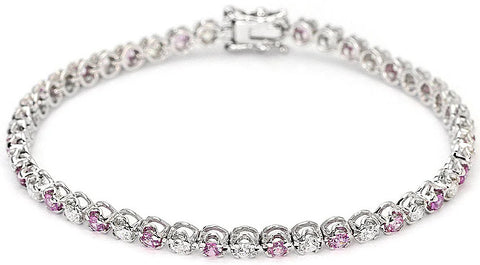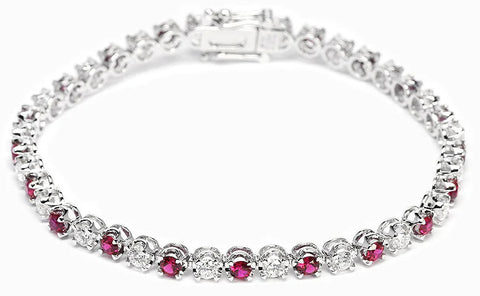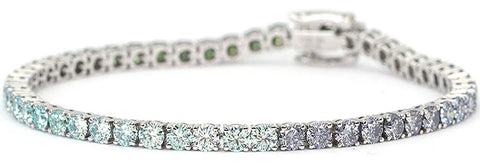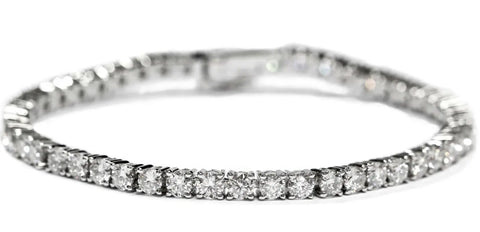Lab-Grown & Moissanite Tennis Bracelets: The Perfect Diamond Alternatives
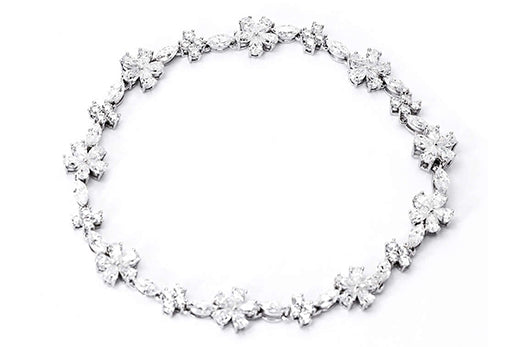
Table Of Content
Flashback to 1978, Chris Evert's gold and diamond bracelet fell off during one of the early rounds of the U.S. Open. The subsequent attention paid to this news made these staples of the jewelry world become known as "tennis bracelets." Though their minimalistic designs, simplicity, and versatility have bedazzled women for decades before this pivotal moment, this event boosted their popularity even more and gave them a new name. Paired with diamond studs, necklaces, and rings, women can never go wrong wearing tennis bracelets on any occasion.
Diamonds: A Question of Ethical Sourcing
Diamonds are the stars of tennis bracelets. However, the discussion on diamond sources has become more prevalent recently. Though Canada, Russia, Botswana, and South Africa present traditional sources, some pieces have dubious origins. The term "conflict diamonds," or "blood diamonds," became a byword in the 90s and lasted well into the current century. The 2006 movie, starring Leonardo di Caprio, impacted jewelers, requiring them to prepare to counter the negative perception created by the film. The Kimberley Process Certification System was established in 2003 to prevent substantial quantities of these diamonds from finding their way to jewelry stores worldwide. Though this measure intends to provide consumers peace of mind, it can't guarantee that conflict diamonds won’t make it through to anyone buying a piece of diamond jewelry.
Moissanite and Lab-Grown Diamonds: Sustainable and Affordable Choices
Fast-forward to today. Millennials and contemporary jewelry buyers are embracing sustainable gem choices. Aside from being affordable, moissanite and lab-grown diamonds are excellent choices because of their beauty, shine, and brilliance. They match some of the highest grades of diamonds. With a substantial number of stones required to make tennis bracelets, these characteristics make them perfect diamond alternatives.
Lab-Grown Diamond Tennis Bracelets: Guilt-Free Luxury
Since the 1950s, many methods of producing artificial diamonds have been tested. The high-pressure, high-temperature method (HPHT) was the original method of producing lab-grown diamonds. This process mimics the pressure and temperature that form carbons naturally. Gem-quality stones have been produced since the 1970s, when the HPHT process was refined, with the help of the Hall belt press developed by Howard Tracy Hall.
Another method of producing lab-grown diamonds is the Carbon Vapor Deposition Method, or CVD. In this process, diamonds are formed inside specialized machines, where pure carbon is introduced to an original diamond seed after being ionized and broken down. Today, both the HPHT and CVD processes significantly contribute to the worldwide supply of lab-grown diamonds.
Lab-Grown Diamonds are Ethical and Sustainable
Whether through HPHT or CVD processes, lab-grown diamonds are guaranteed to originate from ethical sources. They are produced in specialized manufacturing facilities free from unfair labor practices or questionable methods. Moreover, producing lab-grown diamonds has a substantially lower carbon footprint than traditional mining methods per carat.
Lab-Grown Diamonds Are Physically and Chemically Identical to Mined Diamonds
Like natural diamonds, lab-grown diamonds are made of pure carbon with a crystal structure formed through processes that mimic how natural diamonds are made (which sets them apart from graphite, whose carbon atoms are arranged differently). Only experienced gemologists using specialized equipment can distinguish lab-grown diamonds from natural diamonds.
Lab-Grown Diamonds Are More Affordable than Mined Diamonds
Through several decades of improvements, factors such as quicker production times, shorter supply chains, lower infrastructure costs, and having no rarity factor have made lab-grown diamonds more affordable than natural diamonds. Along with other lab-grown stones, producing masterpieces, such as the mesmerizing Rubetta Lab Grown Diamond Tennis Bracelet, with its shimmering twenty lab-grown rubies and nineteen lab-grown diamonds, are a guilt-free and attainable luxury identical to the best diamond tennis bracelets around.
Moissanite: A Brilliant and Affordable Choice
Moissanite is named after Henri Moissan, a French chemist and pharmacist, who discovered the gem while studying rock samples from a meteor crater in Arizona. Though initially identified as diamonds, these were identified as silicon carbide by 1904. Having the brilliant qualities of diamonds, moissanite is rarely available naturally. Today, moissanites are typically lab-produced. Exceptional pieces, such as the Leanne Gradient-Colored Tennis Bracelets, exhibit everything beautiful about moissanite: stylish, chic, and mesmerizing gradient green moissanite flowing seamlessly within the same color palette.
Exceptionally Brilliant Fire
Moissanite is known to exhibit exceptional "fire," dazzling rainbow flashes appearing when light hits the gem. This sparkle and captivating play of colors add unique characteristics that set moissanite apart from other gems and, in some observers' eyes, exceed the brilliance of diamonds. Looking closer at the Hydrangea Moissanite Tennis Bracelet in person, with its dazzling gray moissanite harmoniously arranged, this exquisite bracelet staggers those who behold it under the light while gently embracing one's wrist.
Extremely Durable:
Moissanite tennis bracelets are perfect for daily use and have exceptional scratch resistance, close to diamonds. Looking back to Chris Evert's famous bracelet incident, these tennis bracelets would have survived!
Affordability and Sustainability
Though a valued gemstone, moissanite is much more affordable than mined diamonds. Today, most moissanites are lab-grown, enabling artisans and jewelers to create beautiful pieces, such as LeCaine's Round Tennis Bracelet in 18K Gold, at a fraction of the price of pieces with the same amount and sizes of natural diamonds. Moreover, manufacturing moissanite takes fewer resources per carat than naturally mined diamonds. Owning moissanite pieces is guilt-free, has ethical production methods, and is free from unfair labor practices.
The Future of Sustainable Sparkle: Lab-Grown and Moissanite Tennis Bracelets
The evolution of tennis bracelets transcends their iconic design. Today, ethically sourced gemstones, such as lab-grown diamonds and moissanite, provide guilt-free choices as beautiful as natural diamond tennis bracelets at a fraction of the price. Whether you are drawn to the guilt-free luxury afforded by lab-grown diamonds or prefer the dazzling brilliance of moissanite gracing your wrist, there's always a perfect tennis bracelet from LeCaine waiting for you.
Visit our store or explore our site to seek a timeless piece that reflects your style and values. We also offer customization options for your lab-grown diamond or moissanite tennis bracelets.
 Skip to main content
Skip to main content


